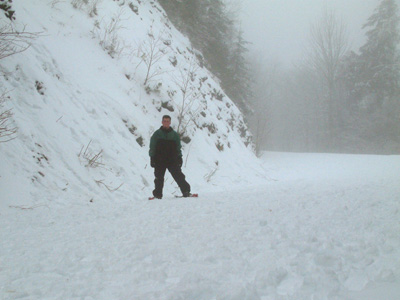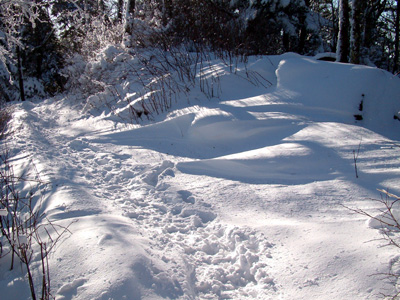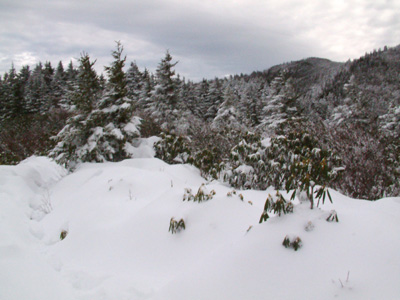Snowshoeing
The upper elevations of the Great Smoky Mountains National Park are probably one of the snowiest easily accessible areas in the southeast. Over the last few years, the Park Service has greatly increased efforts to keep US 441 open as much as possible during the winter, and hurries to get the road clear as soon as possible after every snowfall. The result is easy access to areas that can regularly have 18 or more inches of snowfall several times throughout winter.Snowshoeing is definitely a compromise in energy. Having extra weight on your feet means that you get tired faster and have to put more energy into lifting with each step. On the other hand, you don't have to lift your feet as high, or waste energy packing down several inches of snow with every step. At the end of the day, it means you can go a little farther and faster than if you just trudge through the snow in hiking boots. However, if there are only a few inches of snow, you're just wasting energy by adding extra weight and putting more effort into walking than you need to.
I'm not sure how many people actually go snowshoeing within the park. Some would consider it overkill, but there's nothing like spending your day cutting through untouched snowfall in a spruce-fir forest without having to worry about snow depth. I have seen tracks of skiers along Clingman's Dome Road, but most people just walk a mile or so on foot before turning around. Most areas in the Smokies, if they get snow, only have a dusting or a few inches, which is far too little for snowshoeing. Often, during the middle of winter, a day's worth of cold February rain in the valley means a foot or more of heavy snow above 5,500 feet elevation. During bad weather, I frequently check this Precipitation Table found on the NOAA website, which is updated every morning. When a good snow depth is reported, I head out the door.
These are some of my favorite trails during the winter:
Clingman's Dome Rd:
This road is closed from December to April, and is wide with a shallow grade, making for a great winter trail. When the gate is locked, the road in front is used as a small parking area; just don't block the gate. The first .1 mile is often crowded with kids throwing snowballs at one another, but the footprints slowly taper off as you get farther up the road.

Appalachian Trail (from Newfound Gap):
This trail is heavily traveled even in the middle of winter, so don't be surprised if it's pretty well trampled even 24 hours after a snowfall. The trail parallels the Clingman's Dome Road, and one of my favorite loops is to take the road to Indian Gap and the trail back to the car. From Newfound Gap, the trail ascends through beech forest before entering spruce-fir, and levels off before descending to Indian Gap. To the east, the trail climbs through spruce forests toward Charlies Bunion, but is dotted with large boulders in many places that can be tricky in snow.

Rainbow Falls Trail:
This six mile trail gains nearly 4,000 feet in elevation as it rises from Cherokee Orchard to Mount LeConte. Often, this trail has a gradient of snow that increases quickly with elevation. At the trailhead, the ground may be dry, but you will usually find snow by the time you pass Rainbow Falls. Most of the trail is sheltered from the sun by being on a north facing slope, so snow does not melt as quickly as it does on most other trails. When the depth reaches about 6 inches, it's time for the snowshoes. Within two miles of the top, a conspicuous side trail to Rocky Spur takes you up to the top of this vantage point, then brings you back to the main trail. LeConte regularly has 12-18 inches of snow or more, but people still make the climb to the lodge even in the iciest conditions.
